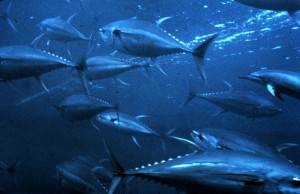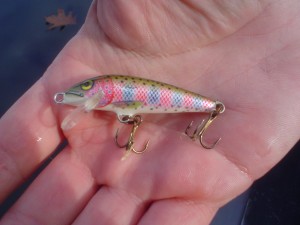The difference between an good fishing trip and an excellent fishing trip could be as simple as a color change of your fishing lure. But what color should you choose. This has been a difficult question that has plagued fisherman for many years. I hope that I can shed some “color” on the matter.
Before I begin let me tell you that there have been numerous times in my fishing experiences that friends of mine have either been skunked or landed many more fish than me all while using the same type of lure, but a different shade of color. That being said color plays an important part of the decision making while fishing.
First we need to discuss some science about color or color wavelengths and how light passes through water. As you may or may not know pure white light is divided into a variety of different colors. Each color has a separate wavelength or frequency. Reds and oranges have a long wavelength, yellows and greens have a medium wavelength and purples and violets have a short wavelength. So why is this important to the average angler. This is important because as the pure white light travels through the water only certain colors can travel to certain depths.
Here is a breakdown of what colors travel to certain depths. Reds are usually the first colors to fade out at around 15 feet of water. After 15 feet of water all red lures appear to turn a shade of grey or black. The orange wavelength can only penetrate the water to about 45 feet of water. Yellows can travel to almost 90 feet of water. Green can travel roughly to 180 feet of water. Blue is next at 225 feet of water and finally Violet can travel roughly down to 300 feet of water.
So why does this happen? Well a little college physics will teach you that water is about 800 times more dense than that air above it. Therefore the light has a harder time penetrating through the water. Light is a very strange phenomenon and their is much study still being researched about it, however what we do know is that light is both a wave and a particle, or at least it acts as both at times. If light is a particle, particles can only penetrate certain substances at certain depths. The shorter the wavelength of the light the deeper it can penetrate the water.
Why is knowing this fact important to the every day fisherman? Simply stated you don’t want to use colors that will appear grey or black at certain depths. For instance you would not want to use a red fishing lure at 50 feet of water as the color will be doing you no good at that depth. If you are fishing a small shallow freshwater lake you would be able to fishing using just about the entire spectrum of colors, but if you are fishing 30 feet + then you need to start considering the depth at which colors can travel through the water. A deep water photographer will tell you that after certain depths all of the shots taken will start to look blue shifted as that is the most dominate wavelength at deeper depths of the water. This is also important to note because after certain depth you many want to start thinking about the fishes others senses other than its vision. Like its sense of smell or hearing.
Some fisherman may argue that it is all irrelevant as fish don’t see in color anyway, however there has been scientific studies on the numerous fish species eyes that indicate that they have the same rods and cones that the human eye has, which indicates that they can indeed see in color much like we can.
Another factor to consider is the current condition of the surface water. Is the water flat or is it choppy. How well do you think the water can penetrate the surface at the present moment. Obviously on calmer days water can penetrate much deeper than on days where there are rough water conditions. I generally choose yellows and greens on days when the surface water is rough. On calmer days I like me reds and oranges and I would like to believe that the fish agree with my decision.
Water is never 100% clear either so you should factor this into your thinking. In mid summer the pond or lake may be full of phytoplankton or micro organisms that is cloading up the water. This cloudy water will cut down the overall depth of the color spectrum. Reds may only be able to penetrate 10 or even 5 feet on these days. A yellow may work much better.
The angle of the sun also plays a role as the sun at 12:00 noon can penetrate much deeper then the crack of dawn. A certain color may only produce good results for a few hours time before some other factor changes.
Pay attention to the color of the surrounding bait-fish. If the bait fish are silver-sides and you are using a red rebel you may want to reconsider your color choice to something more metallic in order to more closely resemble the current prey that they Bluefish or Stripers are feeding on.
If you are still confused as to what color to pick, you can always use a multicolored plug or lure. I have a small rainbow trout plug that has all colors of the spectrum in it so I know I am covered when I use it.
In summary below is the Color Cheat Sheet that I use when trying to decide what color to use.
- Depth of the Water
- Surface Conditions
- Clarity of Water
- Existing baitfish in the water
- How good the fish can see (Walleye and Bass have excellent vision)
- Current Time of Day
- Current Moon Phase
- Water Temperature
Here are some example scenarios.
- If you are fishing for deep water trout in a and the water is fairly murky with a temperature of 60 degrees. What color should you choose?
– Red
– Blue
– Green - If you are fishing for stripers and you know they are taking surface plugs with a fill moon behind your back with clear water. What color popper would you consider?
– Red
– White
– Blue
– Yellow
There may be much debate over the correct answers, but in general in the first scenario you probably want to stay away from the red colors. In the second scenario you probably want something a little reflective to catch the glare of the moon so the white, yellow or even red may work well, but definitely not the blue.
Please feel free to leave comments about this post below. I am curious to know what other anglers have to contribute about choosing the right color fishing lures.



One thought on “What Color Fishing Lure Should I Use?”